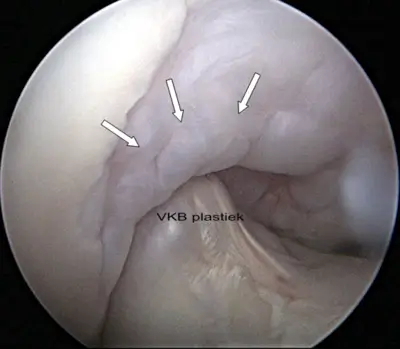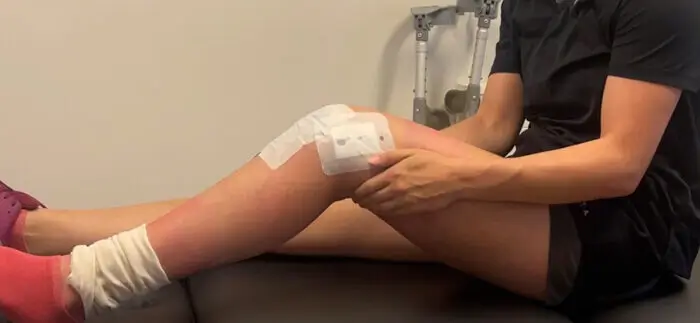
Moeite met strekken na en voorste kruisband operatie: littekenweefsel
Do you have trouble extending your knee properly? One possible cause could be scar tissue. In this blog series, we discuss the most common questions after anterior cruciate ligament surgery. Today's focus is scar tissue, also known in medical terms as a cyclops lesion. You'll get answers to the questions: what is scar tissue, how does it form, and why does scar tissue form after anterior cruciate ligament surgery? But of course, the two most important questions are: is it harmful and what can you do about scar tissue, or cyclops lesion.
Difficulty extending the knee due to scar tissue
What is scar tissue?
Scar tissue is another word for connective tissue that is formed at the site of damaged tissue. The body uses scar tissue to repair what is broken, such as after a wound, inflammation or surgery. The tissue is stiff, lacking in elasticity and randomly arranged. That the body needs to heal after damage should go without saying, but scar tissue follows its own plan in certain cases. A typical example with the knee is a cyclops lesion after anterior cruciate ligament surgery. Clients complain of difficulty stretching the knee, pain in random places and walking is often difficult.
How do scar tissue or cyclops develop in the knee?
The body tries to repair anything damaged or broken through scar tissue. In anterior cruciate ligament reconstruction, tunnels are drilled into the upper and lower leg bones. Through these tunnels, the new anterior cruciate ligament is pulled. The body begins sealing these tunnels, during which time excessive connective tissue may be produced, leading to a cyclops lesion in the knee.

Why can't a knee with scar tissue extend?
Understanding this requires some anatomical knowledge of the knee. The location where the anterior cruciate ligament is placed in the thigh bone is called the notch. The size of this space, the notch, is limited, which can cause a problem if scar tissue develops. One reason may be that the knee does not stretch enough in the early stages of anterior cruciate ligament rehabilitation. Another reason is mostly bad luck. It happens to you for no apparent reason. The formation of scar tissue in the already limited space usually results in a stretch limitation.
Is scar tissue or cyclops lesion in the knee harmful?
After an anterior cruciate ligament reconstruction, little seems to be wrong in the first few weeks. Over time, however, it becomes increasingly difficult to fully extend the knee. After practicing and mobilizing the extension, things seem to improve again until the next physical therapy session. The knee usually becomes stiff again during the treatment, and this ritual repeats itself week in and week out. Stretching can sometimes be progressively limited, with values between 5 and 30 degrees. While a stretch limitation is not necessarily harmful per se, it does not promote rehabilitation at all. A limitation in extension leads to abnormal standing and walking patterns, and the muscles (quadriceps) cannot be trained optimally. Such restriction can tend to make rehabilitation failure.
What can you do about scar tissue or cyclops lesion in the knee?
Practicing stretching immediately after anterior cruciate ligament reconstruction is very important and reduces the risk of scar tissue formation. Still, a cyclops lesion may develop, sometimes a-symptomatically (without symptoms). If stretch limitation does occur, a physician may consider performing an MRI scan. Unfortunately, a cyclops lesion is not always recognized on MRI images. In such cases, it is often advised to continue with exercises aimed at improving the stretching. If the stretching does not improve, strength lags and the client experiences pain, then keyhole surgery may be considered. During this procedure, scar tissue is removed. It is essential to start physical therapy immediately after surgery, aimed at improving extension and training the quadriceps. This is because the knee tends to re-stiffen or regrow scar tissue. After removing the scar tissue, clients often experience tremendous relief and a sense of freedom of movement.
For a longer time, I thought that not being able to fully extend my knee was part of it. My physical therapist began to have doubts and I made an appointment with my orthopedist. There was nothing to see on the Mri, so I continued training. It didn't get any better, so I scheduled an exploratory surgery. The doctor was shocked by the amount of scar tissue. It was clear that this was the explanation for the inability to extend my knee. After my surgery I am recovering well and I am finally seeing results from my training.
At first it went well, but completely stretching never really worked. The knee was usually restricted 5 to 10 degrees with extending. Every week I got exercises and the physical therapist mobilized my knee. Nothing seemed to help. The doctor was reluctant to schedule surgery and suggested I keep exercising. After several months anyway, I had surgery and immediately felt the difference. Hopefully back on the sports field soon.





Trackbacks/Pingbacks